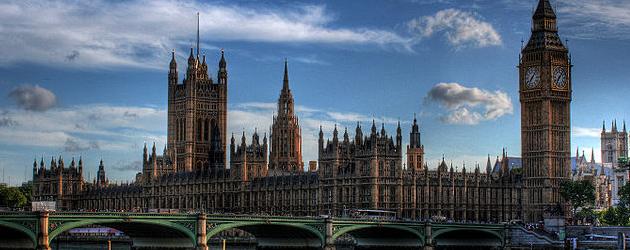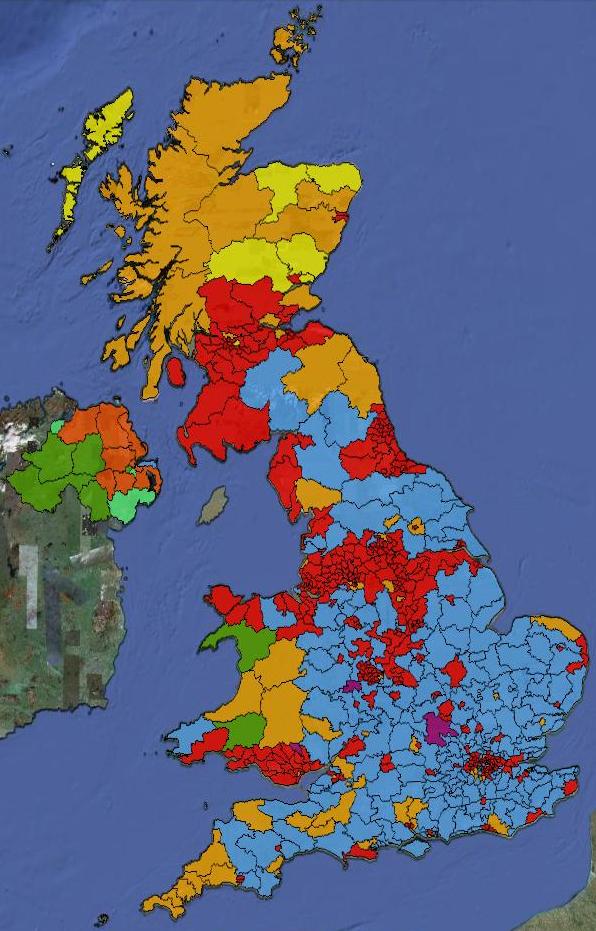
British voters go to the polls on 6 May 2010 to elect 650 members of the new House of Commons. After thirteen years in power, Gordon Brown’s Labour party is being challenged by David Cameron’s Conservative party and Nick Clegg’s Liberal Democrats, along with many other smaller parties.
The UK electoral map
There are 650 constituencies across the UK which will elect Members of Parliament on 6 May. There are great disparities between the voting patterns of different parts of the UK. Even at their lowest ebb, the Conservatives dominate elections across the South of England. In the South West, the Liberal Democrats perform particularly well, pushing Labour into third place. Labour does particularly well in the big cities. They dominate the electoral map in London and in the large urbanised belt that takes in Liverpool, Manchester, Leeds, Sheffield, and parts of Nottinghamshire and Derbyshire, as well as the urban area around Newcastle in North East England and the area around Birmingham. The Conservatives dominate areas outside the big cities, although Labour also holds a number of seats covering big towns, surrounded by rural Conservative seats.
Labour also dominates in Scotland and Wales. Labour has almost complete domination over the Central Scotland belt that takes in Glasgow and Edinburgh. The Conservatives lost all eleven Scottish seats they held at the 1997 election, and have only managed to win one of these seats back. The Liberal Democrats also perform very well in Scotland, holding more seats than in any region other than South West England. The Scottish National Party also holds a handful of seats in Scotland, although except for one Glasgow seat won in a 2008 by-election, the party’s seats are all in the northern parts of Scotland.
The Conservatives were also wiped out in Wales at the 1997 election, but won back three of their seats in 2005. Labour is dominant in urban South Wales and in North Wales, while rural central Wales is dominated by the Liberal Democrats and the nationalist Plaid Cymru.
Politics in Northern Ireland is dominated by nationalist and unionist parties, with the major parties of Great Britain largely absent. Over the last decade, the moderate Ulster Unionist Party and Social Democratic and Labour Party have been largely sidelined by the hardline Democratic Unionist Party and Sinn Fein.
Redrawing the boundaries
Boundaries for UK parliamentary constituencies are usually redrawn once every 10-15 years. The last set of boundaries were drawn between the 1992 and 1997 election, and thus a redistribution has recently been undertaken. Following the creation of the devolved Scottish Parliament in 1999 the number of seats for Scotland in the Commons was cut from 72 to 59 between the 2001 and 2005 elections, meaning that Scotland’s redistribution was moved up, and implemented prior to the 2005 election.
The new boundaries for England, Wales and Northern Ireland were drawn since the 2005 election. The number of seats remained at 40 and 18 respectively for Wales and Northern Ireland, while England’s seats were increased from 529 to 533.
There are a number of competing calculations determining what the notional results of the 2005 election would have been on the new 2010 boundaries. Most of the UK media are using the calculations produced by Colin Rallings and Michael Thrasher. There is an alternative version produced by the psephological blog UK Polling Report. The difficulty in producing a definitive set of notional margins is due to the fact that all votes are counted at a central location for each constituency, meaning that there is no data available about how each polling booth voted. Calculations, therefore, are produced using a mixture of national election data and local council election results.
There are some variations between the two methods, which are outlined at the UK Polling Report blog. According to UK Polling Report, the new boundaries give Labour 344 seats (-12), Conservatives 214 seats (+16), the Lib Dems 63 (+1) and Plaid Cymru 2 (-1), with no changes to numbers in Northern Ireland or Scotland. Rallings and Thrasher predicts Labour 349, Conservative 210, Lib Dem 62 and Plaid Cymru 2.
Throughout this election guide I have tried to use UK Polling Report figures. While various calculations can produce different results, they don’t change the basic map, in terms of the sort of swing the Conservatives need to win, or where particular seats sit on target lists.
Regional guides
The territory of England is usually broken up into nine government office regions for various purposes, including elections to the European Parliament and for the Greater London Assembly. I have written up guides for the election in each of these regions, and in Scotland, Wales and Northern Ireland, including a variety of maps showing the political landscape, as well as a list of the key seats in each region. Click through to guides to the election in each region of the UK:
- London
- South East England
- South West England
- Eastern England
- East Midlands
- West Midlands
- North West England
- Yorkshire and the Humber
- North East England
- Scotland
- Wales
- Northern Ireland
You can also download Google Earth maps showing constituencies in England, Scotland, Wales and Northern Ireland. You can also download maps showing the constituencies used at the 2005 election prior to the latest redistribution in England, Wales and Northern Ireland.


Debate bingo anyone?
Now there’s another idea we could copy in Australia.
And we all know how they say Aussies will bet on anything – well really its the Brits who will bet on anything. Check out all the things you can bet on with Ladbrokes, particularly on the debates. I’d love an account with one of those agencies – lousy Centrebet just has the single market on who will win, which, mind you, is looking interesting with Labour at a plump $5.20, despite a strong chance they will still emerge as the largest party.
Was it a deliberate decision to find the least flattering photos possible of the party leaders on this and the Australian guide??
No…
http://www.guardian.co.uk/media/gallery/2010/may/06/general-election-2010-newspapers-front-pages
Election Day front pages. The Murdoch press leads with its usual subtlety.
I suppose I should extend that the the tabloid press. The Mirror isn’t exactly backward in being forward.
The Guardian have provided a link to this which paradies The Sun’s front page:
http://www.twitpic.com/1lcq0v
I was actually a bit surprised the Guardian went with a picture of Cameron considering they endorsed the Lib-Dems.